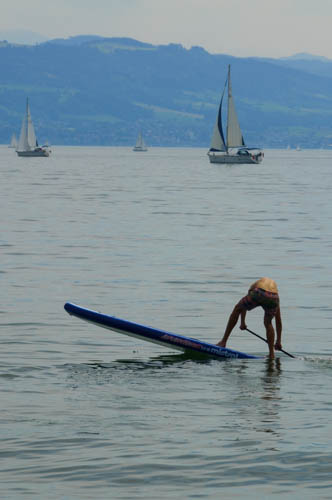A little paddle board theory never hurts – that’s why we explain the most important things about paddle board riding technique.
Before you want to buy a paddle board, you should know how to use it. Therefore we have compiled this article for you.
The Paddle Board driving technique basics
With slightly bent knees you should stand with your feet about hip-wide apart and parallel at the height of the Paddle board’s centre of gravity on the board. Usually the middle of the board is in the area of the carrying strap. Bent knees make it easier to balance out waves. You have to stand loosely and not tense and stiff – otherwise you will make too big compensating movements and the movement of the water will be even stronger.

The first time you stand on a paddle board the feeling is still very shaky – but don’t worry, after a few minutes this will pass most people, as your body and muscles slowly adjust to it. If you are now standing correctly, you can start paddling. The paddle is held with both arms. Once at the top of the handle – this is your pressure arm. And once a bit above hip height – this is your pulling arm. The pulling arm remains almost stretched during the paddle movement. The pressure arm guides the paddle movement. This automatically results in an effective paddling and more stability on the board.
A paddling movement starts with the penetration and ends with the retrieval. The puncture is made as far forward as possible in an upright position. After the paddle is in the water the pull is done. Effective paddling is done in front of your body, only there the force can be fully effective. In the water the paddle is always perpendicular to the board or the direction of movement. This is important – otherwise you will unintentionally make steering movements with the paddle, wasting power and not effectively going straight ahead. When retrieving the SUP paddle, the pressure arm pulls the paddle out of the water and guides it forward again above the water surface.
Side change of the SUP paddle
The side change at the paddle comes after 3-6 paddle strokes. The number is individual and varies depending on the board and rider. You will notice yourself when it is necessary to change sides. When changing sides, you release the pressure arm from the handle and slide up the shaft with the pull arm and take the new pressure arm position. The previous pressure arm reaches for the shaft and takes the pull arm position. This movement is executed smoothly. With time, it works by itself.
For beginners this is also nicely explained in this video.
Another paddle board riding technique tip for beginners
If you’re a beginner and still wobbly on the board, wild rowing with your arms to keep your balance won’t help. You will only go swimming faster. Try to push your paddle onto the water and use it as a paddle boardport. You might have to bend your knees even more. Your center of gravity will drop and it will be easier to keep your balance.
Paddle Board technique for advanced paddlers
You have to use your whole body to paddle effectively in paddle board As soon as you use your body to work with the paddling movement through footwork and rotaion you will be much faster. Also a fast but short paddle stroke (only up to your feet) and the effective and fast changing of the paddle side will help you to gain speed.
The “normal” turn – Crossbow
The Crossbow is the easy way to drive or turn a curve with the paddle board. You remain relatively stable, but are relatively slow. You stab with the paddle on the side you want to go into a curve. It feels like the wrong side – but you stab far out and make a circular motion towards the tip of your board. At the tip of the board, lift the paddle out of the water, stab in again on the other side and pull the paddle in an arc to the tail. If you do this with force, a crossbow stroke is enough to make a 180° turn.
The crossbow is beautifully explained in this video:
Cross Step/Kickturn – fast moving on the paddle board
For fast turns (curves) you have to move on the board. To turn in the paddle position in the crossbow is not very fast. At the beginning of a turn, both feet are still shoulder-wide next to each other, we still provide a good amount of propulsion and are approaching the turning point. Then we put one leg shoulder width behind on the centerline of the board. Now your toes point towards the side of the board. Since you have to go very far back on the board to make a quick turn, take the front remaining foot and place it even further back on the board – again, watch the centerline. This is important to keep your balance. The center of gravity is now far back. The tail of your board will sink into the water, the tip will come out of the water. Your weight rests on the back leg. Now you take the paddle and paddle a semicircle in the water in front of you. Depending on which side you want to turn you have to choose the first step accordingly (left or right). If you stand far enough behind you, the turn is done immediately and you can change back to the paddling position with 1-2 steps.
In this Youtube video the whole thing is explained again clearly:
Beginners tips for paddle board riding technique
These will help you get better.
- Don’t lean back – you’ll fall otherwise it’s water. Your center of gravity remains centrally above your legs.
- Keep your knees always bent to be able to react better and faster to irregularities.
- No hectic movements on the board. Always focused and deliberate.
- Love one big step rather than many small steps and look where you want to go – not at your feet!

